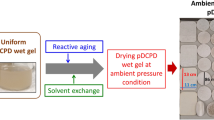Abstract
In this study, polyurethane was blended with silica aerogel to improve its thermal insulation property. The silica aerogel/polyurethane composite with a suitable composition 35/65 (v/v) has low thermal conductivity (0.13 W/m K) and a hydrophobic property (water contact angle of 95.6°). The pore size, pore distribution, and structure of silica aerogel (tetraethoxysilane-based) were studied to select the suitable silica aerogel for blending. The co-precursor method and the solvent exchange method were used to prepare the silica aerogel for comparison. Fourier Transform Infrared spectra confirmed that the co-precursor method created more Si-CH3 groups on the silica surface than solvent exchange method. The silica aerogel prepared by the co-precursor method had a thermal conductivity of 0.032 W/m K with a porosity of 97 %, and a water contact angle of 130°. This silica aerogel prepared was then used to blend with the polyurethane prepared by diisocyanate and poly (tetramethylene oxide), with 1,4-butanediol (1,4-BD) as the chain extender. Silica aerogel/polyurethane composites were formed as films of various compositions by the solvent casting method. Scanning electron microscopic (SEM) photographs revealed that the composites were uniform. The optimal composition of silica aerogel/polyurethane is 35/65 (v/v) with the water contact angle of 95.6° and the thermal conductivity 0.13 W/m K. The silica aerogel/polyurethane composites have no disadvantages of brittleness and hygroscopic property, and possess a low thermal conductivity property.











Similar content being viewed by others
References
Lai YS, Tsai CW, Yang HW, Wang GP, Wu KH (2009) Mater Chem Phys 117:91–98
Seo JW, Kim BK (2005) Polym Bull 54:123–128
Wang Y, Al-Biloushi M, Schiraldi DA (2012) J Appl Polym Sci 124:2945–2953
Gilson PW, Lee C, Ko F, Reneker D (2007) J Eng Fiber Fabr 2:32–40
On NK, Rashid AA, Nazlan MMM, Hamdan H (2012) J Appl Polym Sci 124:3108–3116
Ge D, Yang L, Li Y, Zhao J (2009) J Non-Cryst Solids 355:2610–2615
Rao AP, Rao AV, Pajonk GM (2005) J Sol-gel Sci Technol 36:285–292
Wei TY, Chang TF, Lu SY, Chang YC (2007) J Am Ceram Soc 90:2003–2007
Soleimani Dorcheh A, Abbasi MH (2008) J Mater Process Technol 199:10–26
Bhagat SD, Kim YH, Ahn YS, Yeo JG (2007) Appl Surf Sci 253:3231–3236
Venkateswara Rao A, Kalesh RR (2004) J Sol-gel Sci Technol 30:141–147
Yang W, Wu D, Fu R (2007) J Appl Polym Sci 106:2775–2779
Feng J, Zhang C, Feng J (2012) Mater Lett 67:266–268
Rigacci A, Marechal JC, Repoux M, Moreno M, Achard P (2004) J Non-Cryst Solids 350:372–378
Ye L, Ji ZH, Han WJ, Hu JD, Zhao T (2010) J Am Ceram Soc 93:1156–1163
Rao AV, Kulkarni MM (2002) Mater Res Bull 37:1667–1677
Log T, Gustafsson SE (1995) Fire Mater 19:43–49
Hong J, Choi HS, Lee KS, Shim SE (2012) Polym Int 61:639–645
Rao AV, Kulkarni MM, Amalnerkar DP, Seth T (2003) J Non-Cryst Solids 330:187–195
Prakash SS, Brinker CJ, Hurd AJ (1995) J Non-Cryst Solids 190:264–275
Husing N (2005) Wiley-VCH Verlag GmbH & Co. KGaA, Weinheim p. 27
Sing KSW (1982) Pure Appl Chem 54:2201–2218
Schwarzl FR, Bree HW, Nederveen CJ, Schwippert GA, Struik LCE, Van der Wal CW (1966) Rheol Acta 5:270
Hu AT (1994) Mech Prop Polym Compos 2:335
Acknowledgments
The authors would like to thank the Research and Development Section, Yunlin Branch, Taiwan Textile Research Institute of the Republic of China, Taiwan, for financially supporting this research.
Author information
Authors and Affiliations
Corresponding author
Rights and permissions
About this article
Cite this article
Chang, KJ., Wang, YZ., Peng, KC. et al. Preparation of silica aerogel/polyurethane composites for the application of thermal insulation. J Polym Res 21, 338 (2014). https://doi.org/10.1007/s10965-013-0338-7
Received:
Accepted:
Published:
DOI: https://doi.org/10.1007/s10965-013-0338-7



